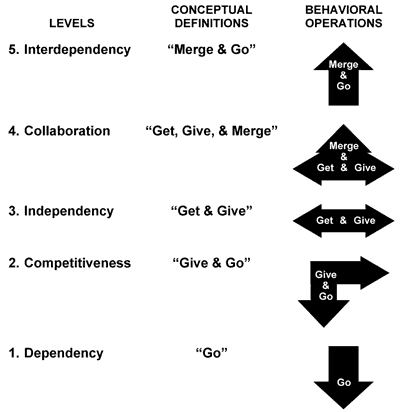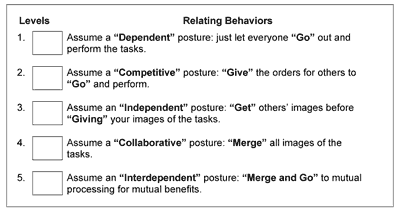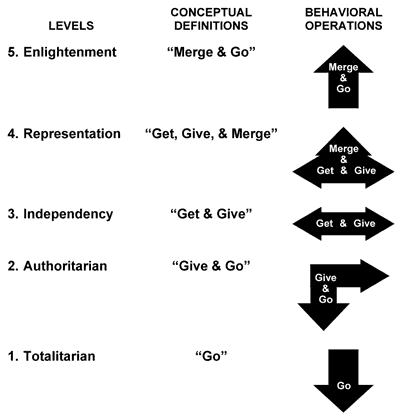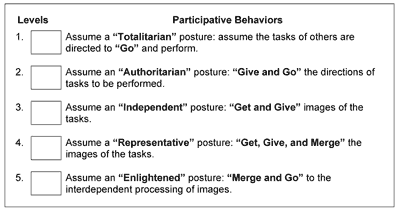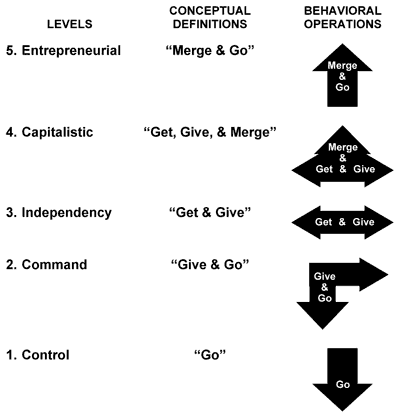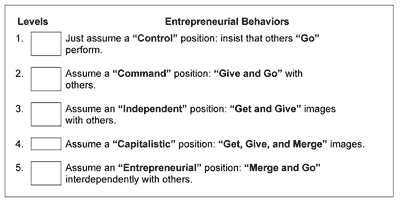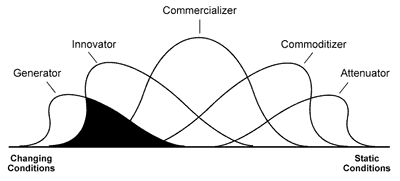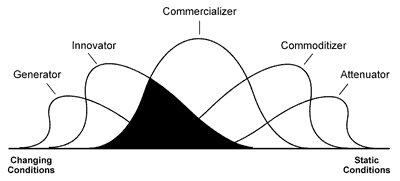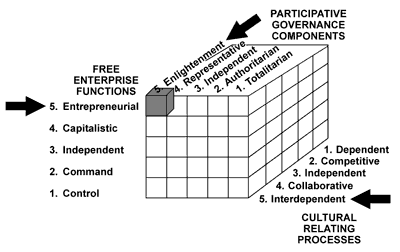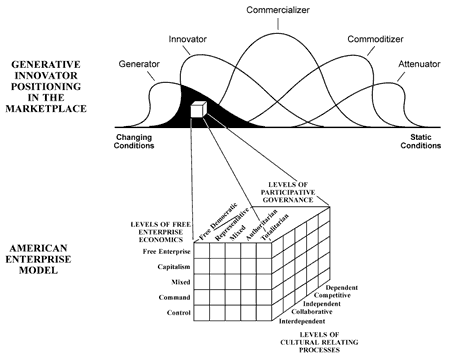Leaders espouse it!
Dictators abhor it!
People celebrate it!
Traitors betray it!
Nations grow with it!
It is inscribed in The Declaration of Independence—Life, Liberty, Happiness.
It is enshrined in The Bill of Rights to the U.S. Constitution—To speak our minds, to petition for grievances, to choose our worship.
It is culminated in the Amendments to the Constitution—XIII versus slavery and involuntary servitude; XV against racial discrimination; XIX in prohibition of sexual discrimination.
It is supported by major movements—Civil Rights, Human Rights, Global Peace and Justice.
It is protected by the “eternal vigilance†that Jefferson prescribed—our statesmen, our military and, most of all, our citizenry.
But no one has defined freedom in operational or behavioral terms!
Here we are guided best by those who hate us most:
“What luck it is for rulers that men do not think.†– Adolph Hitler
How is it that the enemies of freedom are most attuned to its benefits?
The Freedom Functions
In practice, The Freedom Functions have been related extensively to “The Pillars of Civilization:â€
- Cultural Relating → Peace
- Participative Governance → Participation
- Free Enterprise → Prosperity
In cryptic summary, we may demonstrate how “The Historical America†has met these conditions:
- Nearly one century and one-half of Peace between and among its states (Take that, Europe!).
- The first and really only constitutionally-mandated citizens as policy-makers in the history of civilization.
- The most robust economy in world history, leading the “Tsunami Wave†of socioeconomic growth for the world as well as its own individual states over the last five decades.
The Freedom Scores
How is it, then, that the candidates for president in 2008 have not even mentioned these empirically-demonstrated ingredients?
The closest these candidates have come to discussing Cultural Relating is “building walls to keep our neighbors out†(Republican) versus embracing “amnesty†and committing one million tax dollars over the lifetime of the family (Democrats).
Do I hear anybody considering the possibility of Free Enterprise Zones along the border, attracting the ambitious workers from the South and the committed entrepreneurs from the North?
No!
The closest the candidates have come to discussing Participative Governance is “taxing the rich†(Democrats) against “taxing the poor†(Republicans), all the while “tapping†their Political Action Committees funded by the Multinational Corporations.
Do I hear anybody discussing the elevation and acceleration of Education, Empowerment, and Economics for “We the People?â€
No!
The closest the candidates have come to considering Entrepreneurial Enterprise is to consider H.R. 1908, dedicated to rendering American entrepreneurs, the source of over 80 percent of our innovation, impotent by replacing “First to Invent†with “First to File†and “Most to Spend.â€
Do I hear anybody discuss building upon Entrepreneurism, America’s historically “Secret Engine†in the Free Enterprise Marketplace?
No!
If you have not heard these or similar proposals, then you will rate the candidates as “Zeroes†on their Freedom Scores: Zeroes for their knowledge on America’s effective ingredients; Zeroes for their performance in “Spinning the Sham†or “Baiting the Switch!â€
“Zeroesâ€â€”that’s what we rated them.
Sample Scores
If you think you heard something relevant from the candidates, or inferred something relevant, or just happen to like the guy or gal, then consider the illustrations in Table 4. As may be noted, only one illustration is indicated at each level of every scale. Generative illustrations are potentially infinite.
For example, we have not heard of Prosperity Border States and Enterprise Zones, let alone Building Bridges. Yet these offer exponentially more promise for relating, governing, and wealth-generating for ourselves and our neighbors. Good fences did not make good neighbors, not even in Robert Frost’s New England where it preceded the genocide of the American Indians by the crazed and monolithic Puritans!
Since Ross Perot, we have not been reminded of Electronic Town Meetings with Enlightened Citizens Empowered on Issues, let alone educating students by something other than “Every Child Left Behind†memorization systems. Oh, yes, there is a benefit to learning English, “by far the most operational language for science and technology†(check the Nobel Prizes—you have to live in America or work with Americans if you want to learn to think generatively).
The R & D that drove the American Capitalistic system has been abandoned, along with the generativity of the Xerox Learning Center from which all the alleged IT innovators stole their variations of binary function processing. Is R & D coming back?
As Zhu Min, general manager of the state-owned Bank of China suggests: “Manufacturing is gone; services are going; research and development is still there. The U.S. needs to move up the development chain.†(Do not blame the messenger: “Steal once, blame you. Steal twice, blame me!â€)
Table 4. Sample Ratings of Unexplored Political Issues
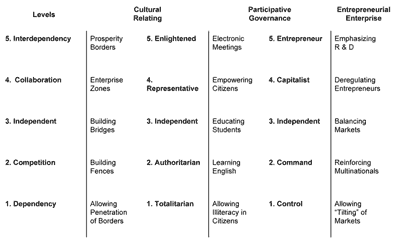
Also to be considered in rating levels of behavior is the mode by which the candidates arrive at their proposals. For example, First Lady Hillary Clinton did an authoritarian “Give and Go†(absent many of the organizations and people affecting or affected by health care) for her Healthcare Plan before her husband’s first administration.
The following categories have “dysfunctional autonomy:†they simply do not relate to the effective ingredients of American Civilization. Indeed, because they are incomplete based upon “differences†rather than “similarities,†they have all been “depressor variables†for our brief 230+ year history: that means that, like the current administration’s “War Presidency,†they contribute only to the retrogression of the ingredients that make a true difference in American Civilization. What follows is a comprehensive picture of candidacy; you may wish to consider a partial list of twelve crudely formulated issues that are “historical depressor variables†for the great civilization that this country could become:
- Bureaucracy!
- Class and caste!
- Ego!
- Ethnicity!
- Demographics!
- Grades!
- Identity!
- Idiosyncracy!
- Intelligence Quotient!
- Race!
- Religion!
- Sexual Orientation!
These are not the dimensions that made America great! Judging by the candidates’ eagerness to discuss them as issues, they are the dimensions that are currently making America stupid!! And we do not consult our faith as a replacement for using our brainpower!
Indeed, there is a principle to be derived from the current presidential campaign: the time spent on campaign issues is inversely related to their importance for the survival and growth of American Civilization.
The American Experience
The only cultural experiences that make a difference are summed under “The American Experience,†the most powerful formulations that Human Brainpower has made. All other interpretations are “self-serving superstitions.†Those people who go through The American Experience fully, survive and grow. Those who do not, wither and die—intellectually, emotionally, physically! No matter the demographics and other depressor experiences!
Finally, here’s a picture of the issues for 2008. Together, they converge to require a whole new “American Manifestoâ€â€”“The Declaration of Interdependence†to accomplish “The Pillars of Civilization:â€
- Peace through Cultural Relating
- Participation through Participative Governance
- Prosperity through Entrepreneurial Enterprise
The Third Way

We’re still looking for “The Third Way!â€

